- Juan Alamo
- Lizz Wright
- Adam Maalouf
- Nacho Arimany
- Rohan Krishnamurthy
- Casey Driessen
- Bolokada Conde
- Billy Jonas
Layne Redmond
Primary Instrument: Frame drums
What She’s All About: As both a player and a historian, Redmond is considered one of the foremost authorities on frame drums — essentially any drum with a width that greatly exceeds its depth; the tambourine is the most common modern example. Voted by DRUM! Magazine as one of the “53 Heavyweight Drummers Who Made a Difference in the ‘90s,” she began working with frame drum specialist Glen Velez in the early ‘80s. Like her teacher, Redmond’s style draws from various traditions from around the world. And there are a lot. Frame drums are one of the earliest known forms of percussion with deep roots in the Middle East and Mediterranean. Her book When the Drummers Were Women explores the early history of the frame drum and its beginnings as a female-dominated form.
On the Frame Drum: “It was one of the earliest ways to amplify the voice, like the earliest microphone. We see images going back 4,000 years, and you can still see today there’s a whole style of traditional singing in Iran where the frame drum is held up near the mouth, so it becomes the echo chamber and amplifies the voice and amplifies the harmonic overtones. So that’s a really important thing. You’re really hearing all the overtones. That to me is what’s very special about the frame drum. It’s all played with the fingers. It’s very subtle technique with all of your fingers. Each finger creates a different overtone.”
Bolokada Conde
Primary Instrument: Djembe
What He’s All About: Among the world’s foremost masters of the djembe, a skin-covered and goblet-shaped drum that originated in West Africa, Conde is an expert in African musical traditions and an ambassador for that culture throughout the world. Hailing from Guinea, he began touring the world in 1996, eventually moving to the United States in 2004. These days, he teaches as much as he plays, opening up players of all levels to the musical traditions of his people. He has been featured on the IMAX documentary PULSE: A Stomp Odyssey as well as a host of CDs and DVDs. His style is frenetic but beautiful, uniting wild abandon with emotional immediacy.
On the Joy of Teaching and Playing: “I love music. Music cleans my body. It makes me happy. It connects me with anybody that plays. I have more energy. I have more experience. Someone is going to be my friend because we love the same instrument, so I love for anybody to play djembe and I love to teach.”
River Guerguerian
Primary Instrument: Hybrid setups, frame drums
What He’s All About: Born in Montreal to Armenian-Egyptian parents, Guerguerian was destined to pursue sonic diversity from the start. He studied music at the Manhattan School of Music and fell in with the varied experimental sounds bouncing around New York. In the mid-’90s, he sold all his possessions and spent five years living in a wildlife sanctuary in the Himalayas. This immersion in nature initiated intense research into the physiological effects of sound, an effort that helped spawn the otherworldly drones incorporated into his Grooves For Odd Times collection. He is skills extend to a wide array of instruments: He’s spent time studying frame drum technique, which he will show off when he collaborates with Layne Redmond and others at APF to recreate an ancient Greek song. He is also proficient with Middle Eastern and Afro-Cuban percussion, marimba, tabla, kanjira, cajón, gongs, singing bowls and various found objects. He also has a penchant for loop effects. He now resides in Asheville.
On Diversity: “The older I get, I still feel like I’m trying to refine everything, I started off playing so many different instruments because it just appealed to me. I was in an area where that was accessible, and I just loved it. I really love different tones. Every time of the day, you want different tones. I’m drawn to the gongs and the bowls for the meditation aspect of it and then really hardcore stuff, I love it when people dance, and I love to dance to my stuff. And then stuff somewhere in the middle. They all feed me in different ways.”
Lizz Wright
Primary Instrument: Vocals, djembe, tangira, cohon, tambourine
What She’s All About: At this point in her career, Wright is more renowned for her singing than her drumming. Her eclectic and vivid style of R&B keys on her softly smoldering vocals. Her fourth album, Fellowship, was released in 2010. But Wright’s got more going on than just a wonderful voice. She’s been studying with Guerguerian, learning her way around a diverse spread of percussion instruments. She’s already been on one tour that featured her rhythms as prominently as her singing, and while this is her first percussion festival, her unique perspective should prove quite valuable.
On the Relationship Between Rhythm and Vocals: “I think I have something to contribute in the way of talking about the virtues and the habits and mindsets that makes the drummer a great pairing with the voice and also just where the voice and drums meet in the tradition of storytelling. I always tell my drummers that if at any point I stop singing, then the audience should know what the story is, have a notion of it, from what they’re playing. I really enjoy drummers who really give themselves the authority to animate music, to tell the story along with me and to really ride in the front seat with the voice to relay the message and to lead the band in dynamics and things like that. I’m excited to talk about that.”
Casey Driessen
Primary Instrument: Fiddle
What He’s All About: Born to a banjo-and-pedal-steel-playing father, Driessen’s first fiddle was a cardboard box with a paint stirrer for a neck and a wooden dowel for a bow. He received a degree from Boston’s Berklee College of Music and has been pushing his technique forward ever since. The percussive elements of his playing derive from a style called “the chop,” which mimics the rhythmic playing of the mandolin in the way the bow taps the string. He’s expanded that ability with a variety of loop pedals and effects, building solo shows into manic sprees of expression.
On Violin as Percussion: “I think the stereotype is that people don’t think of percussion as being a melodic tool. However, drummers are tuning their drums. They’re picking certain bells for the pitch. They actually are paying a lot of attention to melodic content. It’s just not quite as flexible as you’re going to have on a melodic instrument. What I’m going to be able to do is bring another kind of melodic content. With the violin, you can play long notes and sustain. There’s going to be a good contrast between the violin and percussion instruments, but there’s also going to be a lot of good overlap between my percussive elements and their melodic choices.”
Rohan Krishnamurthy
Primary instrument: Mridangam
What He’s All About: Krishnamurthy first picked up the mridangam at the age of eight. An Indian drum known for its deep notes and extreme difficulty, he progressed swiftly, letting neither the tedium of his learning or a childhood move to Massachusetts stunt his advancement. These days, he’s become a master of his instrument, as well as a skilled purveyor of South Indian music and culture. He’s also taken on the role of teacher, serving as an ambassador for his music by teaching it to others. His most recent post finds him sharing his techniques at Rochester’s Eastman School of Music.
On Education: “Tradition and innovation are two sides of the same coin, in my opinion. I’m interested in both. We often talk about music as the universal language, but, in fact, music is not a universal language. There’s music all over the world, but there are different types of music. The different aspects of the musical tradition have to be explained for people outside the tradition to understand it. That being said, rhythm is universal. Rhythm is something we find all over the world.”
Nacho Arimany
Primary Instrument: Ethnic drum set
What He’s All About: Arimany is known for his touch with flamenco rhythms, but his sound draws from more than just that one style. He blends flamenco — born in his homeland of Spain — with inflections of African, Afro-Cuban and Arab rhythm. His Nacho Arimany World-Flamenco Septet is an explosion of Latin fervor, modern jazz complexity, and various other strains of world music that Arimany has picked up over the years. He primarily plays what he calls his “ethnic drum set,” which features him sitting on the ground surrounded by a diverse array of percussive instruments: Nigerian oodo, cajón and Wind and Eagle whistles from pre-Hispanic Mexico are but a small segment of the spread. He also innovates the ways his instruments can be played, doing things like floating drums on water to alter their sound.
On Flamenco: “It’s like having a master’s degree in percussion. It has developed all these rhythms and polyrhythms, and thanks to that I’m able to communicate with any percussionist in the world. You develop amazing skills of rhythm and of listening because flamenco is also a lot of improvisation. It’s not fixed in cycles. You have to listen to what the dancer is doing with the feet and what the singer is doing and what the guitarist is playing. Percussion in flamenco is always accompanying, always supporting, so you have to codify what is going on all the time. Learning that language allowed me to communicate with most of the language of the world. That was my amazing gift from flamenco.”
Kevin Spears
Primary Instrument: Kalimba
What He’s All About: Spears determined he should play kalimba, a small African instrument often referred to as the hand piano, when he was 10 years old. His sister was a big Earth, Wind & Fire fan, and the band’s frequent use of the instrument inspired him to pick it up as well. That he came to kalimba through an outfit blending rock with funk and soul makes sense given his style. When he began to perform publicly in 1998, he quickly realized that he would need to amplify his instrument rather than mic it. He installed pickups into his kalimba, and that opened the door to effects and loops, both of which he now employs to powerful effect, building up layers of distortion that enhance his already complex rhythms and melodies.
On Effects: “I’ve always been one that experimented with materials in terms of pushing extremes, in terms of how high you can make something sound or how low, that kind of thing. I applied that interest to kalimba when I was a child. When I first started playing it, I played it acoustically. When I started to play larger and larger venues, and I needed to amplify it. Over the years, I’ve experimented with different things to create the sound that I like. For me, the kalimba represents 20 or 30 different instruments. It can be played in that way.”
Adam Maalouf
Primary Instrument: Cross-cultural percussion
What He’s All About: Maalouf’s style makes him an ideal assistant director for APF. He specializes in cross-cultural percussion, having become proficient on an impressive variety of instruments from all over the world. More than that, he’s well-versed in the traditions and cultures they represent, uniting them in a way that doesn’t forsake their essences. In addition, he’s a proponent of pushing percussion forward with electronics. He plays with many different outfits playing many different styles and has taught workshops and master classes at Rochester’s Eastman School of Music,
On His Philosophy: “Being well-rounded in approach and just being open to new musical ideas and concepts that I might not be comfortable with, sooner or later, you become so comfortable with everything around you that you can kind of just move from one thing to another seamlessly and just blend in in a variety of musical situations like a chameleon, be that playing drum set in a jazz band, playing xylophone in a symphony orchestra, or playing congas in a Latin band, or playing frame drum with a Middle Eastern group. You start to internalize all these concepts, and then you can adapt them to different instruments and different musical situations.”
Juan Alamo
Primary Instrument: Marimba
What He’s All About: Few players unite rhythm and melody quite so completely as Juan Alamo. Among the premiere marimba players on the planet, he’s also an able vibraphone player, a composer and an educator. Born and raised in Puerto Rico, he pushes past his primary instrument with projects such as LatinVibes, a group in which he plays vibraphone and serves as director. He released his debut solo LP, Remembrance, in 2007, and he will offer a follow-up later this year. His playing is propulsive and immersive, rich melodies gliding along energetic rhythms.
On Marimba: “As a percussionist, you have the best of both worlds. You have rhythm, and you have melody. When you play marimba, you can do basically everything. The marimba is basically like a piano. You can play rhythm, or you can play melody. The instrument has such a broad range. You can play accompaniment. You can do whatever you want with the instrument. It’s just infinite possibilities on the instrument. That’s what attracts me the most. I can play rhythm, contribute as a percussionist, or I can play melody. I can do everything.”
Matthew Richmond
Primary Instrument: Vibraphone
What He’s All About: Richmond has performed, composed, recorded and taught in many different styles and situations. He’s an exemplary vibraphone player, a unique skill that helps him maintain a constant stream of work. He has added tinkling melodies to the Asheville indie-pop band stephaniesid, and also plays with the Asheville Symphony Orchestra and the jazz-enthused Like Mind Trio. As a composer, he has created scores for ballets and plays. Richmond does a little bit of everything, a practice he believes strengthens each of his individual talents.
On Being Well-Rounded: “I’ve always believed that anything I learn as a musician transfers to everything else that I do. Getting better at one thing is going to make me better at everything. What’s been good for me, being seen as a vibraphone specialist is mainly just that it’s an unusual instrument, I get to explore things. It’s not like I’m just another guitarist who has to try to be special. Being a vibes player gives me a chance to stand out from the crowd, and I can use that as kind of a springboard for all of the other things that I want to do.”
Billy Jonas
Primary Instrument: “Re-percussion” drum set
What He’s All About: Jonas creates what he refers to as his "neo-tribal hootenanny" with a bright tenor voice and a percussion setup dominated by repurposed objects: containers, water bottles, buckets, pots and pans, salad bowls and tin cans. He straps bells and baubles to his limbs, bangs on corrugated drainage pipes, and wears “magic music moccasins” made from Altoid cans filled with ball bearings. But his purpose in all this isn’t just uniqueness. He strives to make music as a way to foster community, creating fun sounds that are accessible to all ages and bringing people together in a celebration of rhythm and life.
On Utilizing Found Objects: “For millennia people have been walking around picking up stuff and knocking it together. When they found something that sounded good, they enjoyed it and refined it. That’s all I’m doing is hearkening back to that ancient and primordial tradition of foraging for inspiration. Any percussionist who’s worth their weight in drums knows that their job is to let the music come through them. I’m no exception. We’re all looking to get out of the way of the music coming through, and if we all know that, then we’re going to find ways to work together and communicate together and ultimately communicate with the audience no matter what kind of instrument we’re playing, whether it’s a drum or a garbage can or a frying pan.”



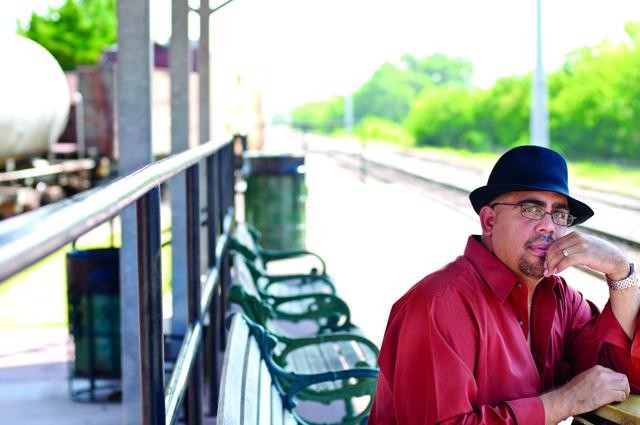


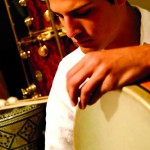
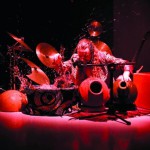
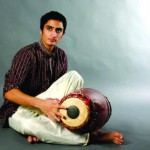
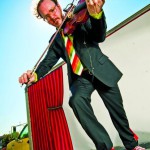

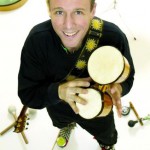
Before you comment
The comments section is here to provide a platform for civil dialogue on the issues we face together as a local community. Xpress is committed to offering this platform for all voices, but when the tone of the discussion gets nasty or strays off topic, we believe many people choose not to participate. Xpress editors are determined to moderate comments to ensure a constructive interchange is maintained. All comments judged not to be in keeping with the spirit of civil discourse will be removed and repeat violators will be banned. See here for our terms of service. Thank you for being part of this effort to promote respectful discussion.